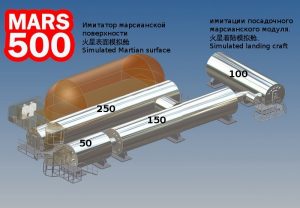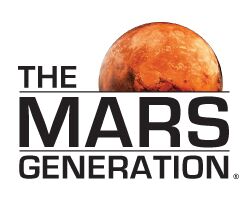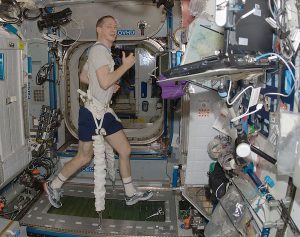We are so lucky to have Ross Wakefield join us as a guest writer.
Please visit our “Get Involved” page to learn more about how you can volunteer and/or join The Mars Generation. Let’s go to Mars!
*** Please note guest submissions are options of the author and do not necessarily reflect the mission or beliefs or The Mars Generation.
Introduction
Previously, we took a look at where the various national, multinational and private space companies around the world were in terms of a possible human mission to Mars – their current capability, a limited look at the technology they are developing for possible future missions, and what their potential time-lines were for a landing on our nearest planetary neighbor.
It is the last of those topics that forms the basis of this first detailed article; the various pressures both mental and physical that astronauts would expect to face on such a long voyage into space, and what methods are being developed – and have already been developed – to be able to deal with those pressures.
What We Know So Far
First Missions, Space Stations
It has been fifty-six years since a human – the Russian Yuri Gagarin – first slipped the surly bonds of Earth and became the first man to orbit the Earth, beginning the journey of humanity into space in earnest. Not too long afterwards, the US sent human missions beyond Earth orbit multiple times, six of which were to land on the Moon. All of these missions were never longer than a few days in length, but all of them made vast and meaningful contributions not only to the strength and tenacity of the human spirit, but also to our knowledge of the environment beyond the Earth and how to survive there. Space, though it may look comforting and awe-inspiring from down on the Earths surface, is dangerous in a multitude of different ways – but more on those later.
In the many years since Apollo 17 returned from the Moon humanity has not sent another human out beyond Earth orbit, but instead has worked on long term habitation in the slightly more welcoming environment of what is called Low Earth Orbit (or LEO for short). Within this very nearby orbital environment, several attempts at long-term habitation have been made in the form of various space stations. At first, the stations were built by individual nation-states rich enough to fund them (such as the US Skylab and the Russian Mir), but after the end of the Cold War enough nations realized that cooperation was the best policy and so first the idea and then the actuality of the International Space Station came into being. Beginning construction in 1998, first inhabited in late 2000, still being adapted with more and more parts as of 2017 and due to be used until at least 2024, the ISS is a truly remarkable success story regarding cooperation in space.
Current Capability and Caveats
Aboard the ISS, a crew of six lives for anything up to 200 days in the course of one ‘expedition’, with three being replaced usually before the 200-day mark is reached. This length of time, coupled with the premise that astronauts can travel to the ISS for multiple different expeditions after spending some time back on Earth, means that many astronauts have clocked up a very great deal of time in space. The current record-holder (as mentioned in the last article) is one Russian Gennady Pedalka, with a grand total of 878 days logged in space as both a member of the crew of Mir and the ISS over five separate space missions. A handful of other astronauts have also logged over 800 days in space, and many more have managed over 500. Through the length of time of these varying missions in orbit, much information has been gleaned about the capacity of the human body to survive in space and how the space environment affects the human body both physically and mentally.
However, while various astronauts and cosmonauts have spent a very great deal of time in orbit, both the length of time and the various difficulties that would be faced are on another scale to what has been achieved so far. The record, as stated above, is 878 days – a remarkable figure, but one what still falls short of the likely mission time-line for a human exploration of Mars. That figure, based on the current plans of various space agencies and private companies, is around three years total – so approximately 1100 days. Also, those 878 days were split into five different blocks – Cosmonaut Pedalka had the chance to return to Earth and the various comforts it offered at reasonably regular intervals to allow himself to rest and recuperate. The members of a human Mars mission would have no such luxury.
With all of that in mind, let’s now expand on what some of those effects of a mission to Mars might be – physical and mental.
The Human Cost
Physical
As mentioned above due to the length of time some people have spent in space we have learned a very great deal about the short and long term physical effects a Mars mission might have on its astronauts. While there are additional factors to be considered when venturing beyond Earth orbit (more on those in a moment), careful analysis of each astronaut put into orbit both while there and once they returned to Earth has given us a reasonably good picture of what to expect.
On the Muscles
The first issue, in the long term, is muscle wastage. When a human being is in a zero-G environment, they will not use many of the muscles that people down on Earth would use without thinking in the course of their day-to-day movements – walking, sitting down, standing up, even the muscle movements that simply keep the human body upright against gravity, amongst others – all movements that would be done without thought on Earth, but have no zero-G equivalent. Because of this the unused muscles will, over time, begin to atrophy away and be no longer able to be used effectively. This would no present a problem if the person in question were staying in space for the rest of their lives…but as it would be nice for them to return to Earth someday, those muscles need to be ready for when they do.
To this end, all space agencies expect and carry out a strict training regimen for their astronaut candidates that rival those of champion athletes. Both before their mission and particularly during, astronaut candidates engage in resistance exercise (weight practice) three to six days a week and aerobic exercise (running, cycling etc) for five hours a week. However recent findings from NASA indicate that even this is not enough; after a six month mission to the ISS, astronauts presented back on Earth with significantly decreased peak power and muscle mass. The addition of more fitness equipment and an even stricter training regimen for ISS inhabitants has helped mitigate this somewhat, but not completely. And this is the effects observed over six months of spaceflight; a mission to Mars would be six times as long.
On The Bones
The second issue is the likely deterioration of bone over a long term space mission. Under normal circumstance, new bone is laid down in the direction of mechanical stress; however in a zero-G environment there is precious little mechanical stress for this to occur. This results in a loss of bone tissue, largely centered on the lower vertebrae, pelvic hips and femurs, making these bones weak. Over a period of time, this results in symptoms similar to people on Earth suffering from the condition osteoporosis – greatly weakened bone which vastly increases the risk of broken bones when the astronaut returns to Earth.
To help counteract this, various space agencies employ the exercise regimen described above (though exercise hasn’t been proven to be useful in preventing bone loss as it has in preventing muscle degradation) and a variety of dietary supplements, most notably calcium and vitamin D. It is also possible that Earth-based remedies for osteoporosis may also work for long-term spaceflight, though once again the effectiveness of such remedies in this application is unknown.
Other Issues
Another big issue is one that cannot be wholly quantified unless a human mission is sent beyond Earth orbit. Once a spacecraft with humans ventures beyond the Earths own magnetic field, the craft will be exposed to all of the radiation (in the form of high-energy elementary particles) that the Sun can throw at it. This as you might have guessed, is not a good thing – these particles act in the same way radioactive fallout from a nuclear explosion or reactor meltdown would on Earth, potentially causing long-term cancers and even acute and fast-acting radiation sickness if the dose is big enough. Over a long time period, even the craft electronic systems themselves begin to fail: the fate of several probes and orbiters sent to various other planets in the Solar System attest to this.
The only way thought of so far to defend against such elementary radiation is to use shielding of various types to deflect the particles and so keep them away from the crew. Of course, the more shielding that is used and the safer the crew will be, the heavier the craft will be and so there are limits on such things. As a result, right now NASA and other various organizations are busy searching for methods that will be both lightweight and able to deflect radiation to an acceptable degree, on the craft going to Mars, the lander, and even the spacesuits of the crew themselves.
There are also other short-term (motion sickness) and long-term (visual disruption and possible inter-cranial pressure) physical effects that could present issues for a human mission to Mars, as well as the simple problem of not being able to return to Earth to receive very advanced medical care if needed – meaning that the astronauts would have to rely on their existing supplies, the medical expertise of those on board, and advice from the ground if needed.
Mental
Almost as important as the physical effects of a long-term zero-G environment is the mental ones. Astronauts from all over the world are trained to be ‘the best’ – the brightest, the toughest, the ones most geared to survival in the harshest of environments – but long-term spaceflight can and will stretch the mind of even the very toughest human being, as history has shown (the Skylab ‘mutiny’ in 1973, where the three orbiting astronauts refused all contact with the ground as well as all duties for a day, was an overt and spectacular example of the psychological pressures of spaceflight as well as other factors reaching critical mass, but many less spectacular examples also exist).
However, measuring and gauging the mental effects of spaceflight on individuals and groups in order to obtain information that could be used in future missions is at least a little easier than for physical effects, as numerous on-Earth comparisons can be found: long-term submarine missions and other isolated military postings, for instance, represent a similar situation to a long-term spaceflight mission – confinement with a small crew within a small habitat and a hostile environment outside. In light of this, there have been numerous discoveries made about the ability of humans to function psychologically in such situations.
More recently, space agencies from various nations have put together initiatives whereby a small crew of humans are subjected to the most realistic simulation of a Mars mission yet: confinement within a spaceship/station-style habitat in a remote area of Earth for a length of time at least comparable with that of a mission to Mars.
Mission Analogs
The analog that NASA uses is named HI-SEAS (Hawaii Space Exploration Analog and Simulation), based on the slopes of the Mauna Loa volcano in Hawaii. Isolated and roughly 2,500 meters above sea level, HI-SEAS began operations in 2013 and has been active every year since, staging ‘missions’ of duration from four months to a year designed to mimic as closely as possible the conditions a crew would experience going from Earth to Mars, and to monitor crew behavior, morale, and stress management and various other factors, all crucial should a human mission to Mars be launched in the near future. The timescale of the missions that HI-SEAS simulates are rather lower than that of current planned Mars missions, but regardless of this the facility continues to produce a wealth of information useful to the future success of a Mars mission.
The Russian equivalent project was named the Mars-500, and was (in the final stages of the project) designed to simulate a full 520-day Mars mission as part of its function. The crew of six – three Russians, a Frenchman, an Italian and a Chinese national – participated in exercises designed to simulate everything, from launch to landing on the Martian surface to walking around in spacesuits on the Martian surface analog. During this year and a half, amongst the various other tests a battery of psychological examinations were given to the ‘cosmonauts’ in order to gauge their various mental states. In terms of such, the results of the simulation were a superb success – the crew were well able to adapt to their environment, there were next to no conflicts amongst the crew, and the possible language and cultural barriers that might have existed between the differing nationalities on the crew turned out to be groundless. It bodes well that a crew was able to survive and function in the way a crew would have to on a Mars mission with next to no visible, significant psychological pressure.
These two analogs, as well as varying other experiments, have given mission analysts a very good idea of the potential psychological problems that could result from spaceflight, as well as various ideas on countering them. These include conferences with friends and family in real time, sending of meaningful gifts, and the celebration of various special days (birthdays, national holidays) in conjunction with Earth. All of these have been at least partially proven to reduce crew stress on either orbital or even lunar missions.
However, both the length of time and the distance from Earth that a Mars mission represents present serious and untested barriers: both communication and the sending of resupply that might be relied upon to improve morale would be severely degraded the further a mission were to venture from Earth, and also the sight of Earth itself moving far away and becoming an insignificant dot in space might well have a negative effect psychologically on potential astronauts. This last factor, however, might be ameliorated by the use of a telescope through which Earth could be viewed.
Conclusion
The information that various space agencies have gleaned regarding the effects of spaceflight on the human body is substantial. Through nearly sixty years of orbital flight, we have been able to assess how exposure to possibly the single most hostile environment known to mankind can affect a human being both physically and mentally. We know that bone degrades after just a short time in space and what supplements to use to counteract it, and we know that long-term missions do not effect crew morale significantly. We know that muscle mass must be retained through the strictest of training regimens whilst in zero-G conditions, and we know that the support role of a mission commander is critical and positive in relation to crew cohesion and being able to ‘get the job done’.
However, for all the information that we have, there are still a great many unknowns that would factor into a human Mars mission that could end up affecting the crew in an adverse fashion. What, for instance, will be the radiation doses from the Sun and other sources that such a mission would have to deal with, and how could they be at least mitigated? How exactly would the human body deal with not just six months, but three years of zero or low-G environment? And when a crew is away orbiting Mars, spending months on end looking at Earth through a telescope, getting communication delayed by several minutes at least and waiting for the right planetary alignment to fire their thrusters to come home…would they really function in the same way as the crews psychologically tested in any one of the analogs used on Earth?
For all that we do know regarding the effects of a Mars mission on the human body and mind, there is still much – perhaps too much – that we don’t know. But, given the information we do have thus far and what we are still learning…by the time we do launch that mission and set out for the Red Planet, we’ll know enough. Enough to get there, to get back, and to tell the tale.
More from Ross:
The Road To Mars: Our Past and Our Future
Going To Mars, Part 2: The Curiosity Rover, A Martian Marvel
Going to Mars, Part 3A: Orion, The Next Generation of Travel
Ross Wakefield is a freelance science writer, communicator and consultant, with specialized expertise in the field of current and historical space developments. Ross has a Bachelors degree in Physics with Astrophysics from the University of Leicester and a CMCU in Astronautics and Space Engineering from Cranfield University and is a member of the Institute of Physics and British Mensa. Ross is currently beginning a series of articles with The Mars Generation on various space-related topics. When he’s not glued to a computer screen, he enjoys playing and watching sport, reading various books and trying to find where the nearest good pool table is in the United States. Find Ross on his Twitter.







[…] Going To Mars, Part 1: The Human Element […]